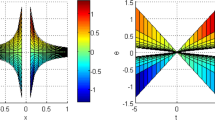Abstract
The boundary-layer equations for two-dimensional steady flow of an incompressible, viscous fluid near a stagnation point at a heated stretching sheet placed in a porous medium are considered. We apply Lie-group method for determining symmetry reductions of partial differential equations. Lie-group method starts out with a general infinitesimal group of transformations under which the given partial differential equations are invariant. The determining equations are a set of linear differential equations, the solution of which gives the transformation function or the infinitesimals of the dependent and independent variables. After the group has been determined, a solution to the given partial differential equations may be found from the invariant surface condition such that its solution leads to similarity variables that reduce the number of independent variables of the system. The effect of the velocity parameter λ, which is the ratio of the external free stream velocity to the stretching surface velocity, permeability parameter of the porous medium k 1, and Prandtl number Pr on the horizontal and transverse velocities, temperature profiles, surface heat flux and the wall shear stress, has been studied.
Similar content being viewed by others
References
Basarab P, Lahno V (2002) Group classification of nonlinear partial differential equations: a new approach to resolving the problem. Proc Institute of Mathematics of NAS of Ukraine 43:86–92
Burde GI (2002) Expanded Lie group transformations and similarity reductions of differential equations. Proc Institute of Mathematics of NAS of Ukraine 43:93–101
Gandarias ML, Bruzon MS (1998) Classical and nonclassical symmetries of a generalized Boussinesq equation. J Nonlinear Mathematical Phys 5:8–12
Hill JM (1982) Solution of differential equations by means of one-parameter groups. Pitman Publishing Co., Marshfield, MA
Hydon PE (2000) Symmetry methods for differential equations. CUP, Cambridge
Ibragimov NH (1999) Elementary Lie group analysis and ordinary differential equations. Wiley, New York
Mahapatra TR, Gupta AS (2002) Heat transfer in stagnation – point flow towards a stretching sheet. J Heat Mass Transfer 38:517–521
Moritz B, Schwalm W, Uherka D (1998) Finding Lie groups that reduce the order of discrete dynamical systems. J Phys A: Math 31:7379–7402
Nazar R, Amin N, Filip D, Pop I (2004) Unsteady boundary layer flow in the region of the stagnation point on a stretching sheet. Int J Eng Sci 42:1241– 1253
Nucci MC, Clarkson PA (1992) The nonclassical method is more general than the direct method for symmetry reductions. An example of the Fitzhugh-Nagumo equation. Phys Lett A 164:49–56
Olver PJ (1986) Applications of Lie Groups to differential equations. New-York, Springer-Verlag
Pop SR, Grosan T, Pop I (2004) Radiation effects on the flow near the stagnation point of a stretching sheet. TECHNISCHE MECHANIK, Band 25, Heft 2:100–106
Seshadri R, Na TY (1985) Group invariance in engineering boundary value problems. Springer-Verlag, New York
Seshadri R, Sreeshylan N, Nath G (2002) Unsteady mixed convection flow in the stagnation region of a heated vertical plate due to impulsive motion. Int J Heat Mass Transfer 45:1345–1352
Vafai K, Tien CL (1981) Boundary and inertia effects on flow and heat transfer in porous media. Int J Heat Mass Transfer 24:195–203
Williams JC, Rhyne TH (1980) Boundary layer development on a wedge impulsively set into motion. SIAM J App Math 38:215–224
Yi Z, Fengxiang M (2000) Lie symmetries of mechanical systems with unilateral holonomic constraints. Chinese Sci Bull 45:1354–1358
Author information
Authors and Affiliations
Corresponding author
Rights and permissions
About this article
Cite this article
Boutros, Y.Z., Abd-el-Malek, M.B., Badran, N.A. et al. Lie-group method of solution for steady two-dimensional boundary-layer stagnation-point flow towards a heated stretching sheet placed in a porous medium. Meccanica 41, 681–691 (2006). https://doi.org/10.1007/s11012-006-9014-x
Received:
Accepted:
Published:
Issue Date:
DOI: https://doi.org/10.1007/s11012-006-9014-x




